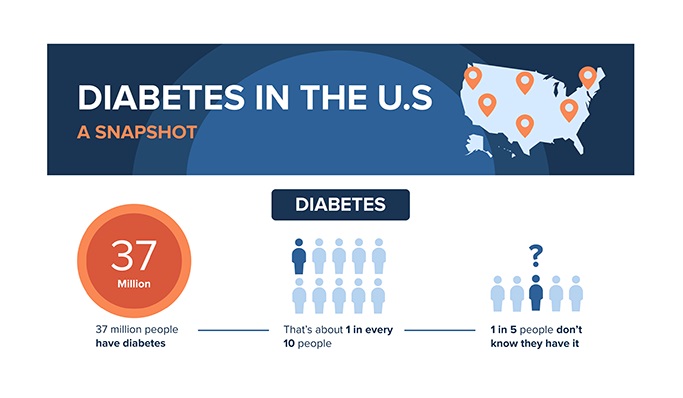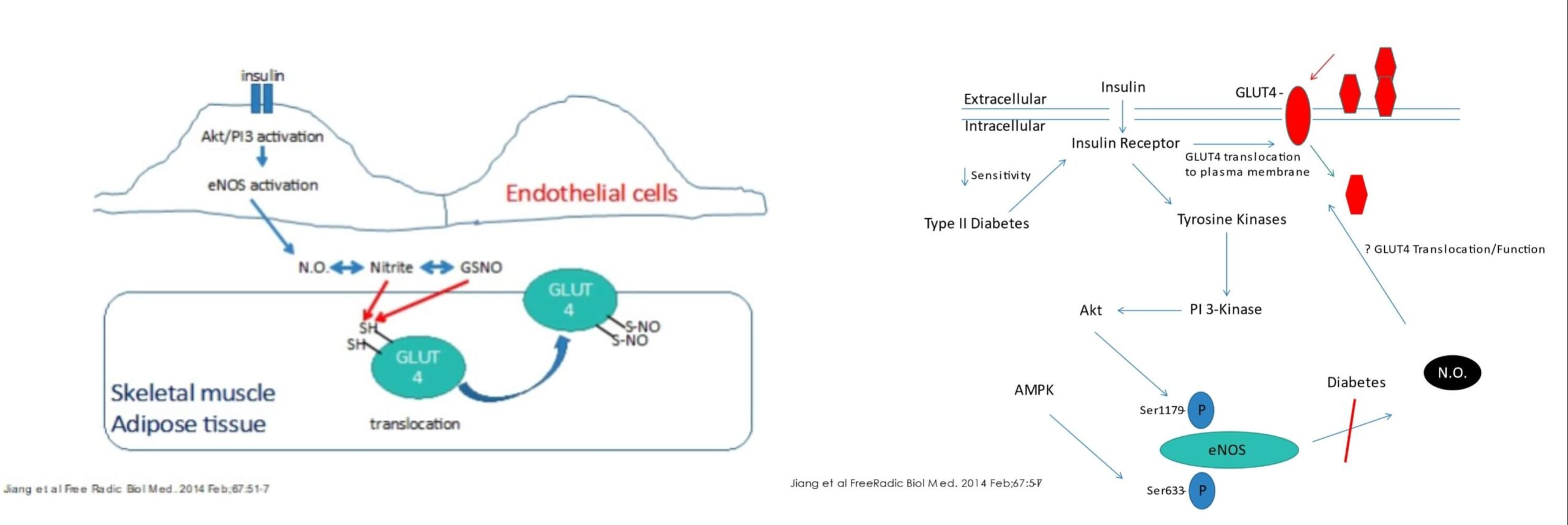DIABETES, A SYMPTOM OF NITRIC OXIDE INSUFFICIENCY

Last month I focused on metabolic syndrome of which insulin resistance is part of the criteria. I received dozens of emails, texts and phone calls on this subject. Since November is designated as National Diabetes Month, I thought it timely to delve a bit deeper into this subject and focus on diabetes.
Taking a quote from the National Institutes of Health, “this year’s focus is on taking action to prevent diabetes health problems.”
I find it interesting that the focus is on actions to prevent diabetes health problems rather than taking action to prevent diabetes itself. We’ve known for decades that type 2 insulin resistant diabetes is self-induced and completely preventable, reversible and curable by diet and lifestyle.
The truth is we know what causes diabetes, we understand the mechanism of diabetes and what goes wrong in diabetic patients and therefore there is a clear understanding of how to overcome and prevent, reverse and cure diabetes.
Despite the clear science, the incidence of diabetes continues to increase.
Diabetes in Numbers
According to the Centers for Disease Control (CDC), in the U.S. alone, there are 37.3 million people with diabetes. That is 11.3% of the US population. Of those, 28.7 million people have actually been diagnosed. There are 8.5 million of the 37.3 million that are undiagnosed.
When we look at pre-diabetes, 96 million people aged 18 years or older have prediabetes. That is 38.0% of the adult US population. That means that half of the U.S. population has pre-diabetes or diabetes. Of those 65 years or older, approximately 26.4 million people have prediabetes or roughly half of all people over 65 have diabetes.
Globally this does not get any better. According to the World Health Organization (WHO), the number of people with diabetes rose from 108 million in 1980 to 422 million in 2014 a 400% increase in 34 years, despite new science on the cause of diabetes.
Diabetes is a major cause of blindness, kidney failure, heart attacks, stroke and lower limb amputation. Between 2000 and 2019, there was a 3% increase in diabetes mortality rates by age.
Worldwide, there are currently 537 million people living with diabetes. This is projected to rise to 643 million by 2030 and 783 million by 2045. This is a staggering statistic that for me is simply unexplainable, unless of course there is a deliberate plan.
Profiting from the Rise in Diabetes
The global diabetes drug market size was estimated at $61.87 billion in U.S. dollars in 2022 and is projected to hit around $118 billion by 2032, growing at a compounded annual growth rate (CAGR) of 6.67% during that 10 year period.
As any business owner would understand, this is a huge and ever-growing market that offers a large opportunity for profits. For metformin (Glucophage) alone, the global market was estimated at $326.52 million, and it’s anticipated to reach $441.58 million in 2028, with a CAGR of 5.16% during those years. The new rage about Ozempic, an anti-diabetic weight loss drug, is estimated to reach $6 billion dollars in revenue this year alone.
Can you begin to understand why big pharma, government agencies funded by big pharma, academia and those who stand to profit on this huge market really have no interest in curing diabetes? There is no money in cures or prevention but billions in treatment and that is what rules the day.
So, we must reach the masses with the true science and teach people how to take care of themselves and reverse their own disease. Big food and big pharma continue to advertise unhealthy foods and diets that can accelerate the onset of diabetes. And guess what, they have drugs to treat the condition they are promoting.
How the Human Body Regulates Blood Sugar
Let’s review what happens in diabetes and then we can begin to instruct on how to overcome diabetes so anyone with diabetes can practice simple approaches to manage and even reverse their disease.
The human body is designed to maintain a very specific range of blood sugar. We need sugar as an energy source and for normal cellular metabolism but too much sugar causes problems. Too little sugar is bad and deadly and too much sugar is bad and deadly.
Therefore, the body has systems in place to maintain normal sugar levels. When sugar becomes too low, we begin to make sugar in a process called gluconeogenesis. This can occur in the liver, muscle and fat cells. This is not a common problem. The problem is too much sugar from our diet.
When the cells in our body sense too much sugar (>100), the body starts an entire process to remove the sugar from the circulation. The process is below:
1. The body senses an elevation in blood sugar
2. The pancreas secretes insulin
3. Insulin binds to insulin receptors on different cells in the body
4. Once insulin binds to insulin receptors, this starts a series of events that instruct the cells to upregulate glucose receptors (GLUT4) to bind glucose from the blood supply and bring the glucose into the cell for storage or energy production.
5. Once glucose is cleared from the circulation, the pancreas no longer secretes insulin
6. Insulin and glucose levels return to normal
This is what is supposed to happen in healthy people after consuming a meal, particular a meal high in carbohydrates or sugar. This all occurs within a couple of hours after a meal.
Insulin Resistance in Diabetics
However, in diabetics this process no longer works as designed.
There is insulin resistance, specifically in type 2 diabetes. This means that the body senses an increase in blood sugar, instructs the pancreas to secrete insulin but the end result of glucose uptake does not happen. This is the basis for insulin resistance. Therefore, the pancreas is instructed to release more insulin and we develop hyperinsulinemia which is extremely inflammatory to the body.
In order for insulin to work, the cell must be able to produce nitric oxide. Once nitric oxide is produced inside the cell, the nitric oxide signals GLUT4 to go to the cell membrane and bind glucose from the circulation and bring it inside the cell.
However, if the cell cannot produce nitric oxide, which does not happen in patients with diabetes, then GLUT4 never gets the signal to go gather up glucose from the circulation.
The Vital Role of Nitric Oxide in Insulin Signaling and Glucose Uptake
In our 2014 paper, we were the first to demonstrate the role of nitric oxide in insulin signaling and glucose uptake. The diagrams from that scientific paper are below.
It is complex biochemistry but suffice it to say that if your body cannot produce nitric oxide, you develop insulin resistance and diabetes. If we can restore the production of nitric oxide inside the cells or provide a source of nitric oxide, then we can restore insulin signaling and improve glucose uptake thereby overcoming insulin resistance and diabetes.
Restoration of nitric oxide can also help potentiate the effects of metformin. Metformin is a drug that targets AMP kinase. Activation of AMP kinase leads to activation of nitric oxide production.
However, if the NOS enzyme is not functional, as in the case of patients with diabetes, there is no nitric oxide produced and the anti-diabetic effects of metformin cannot work. NITRIC OXIDE IS ESSENTIAL FOR INSULIN SIGNALING AND PROPER SUGAR BALANCE.
This also explains why diet and exercise can reverse diabetes. Moderate physical exercise can stimulate and activate nitric oxide production. A diet replete in green leafy vegetables high in inorganic nitrate can improve nitric oxide production thereby improving glucose uptake.
The point is we need nitric oxide in order to prevent, reverse and cure insulin resistant diabetes. If your body cannot produce nitric oxide, you will develop insulin resistant type 2 diabetes. These are the scientific facts that cannot be denied.
5 Steps to Manage Your Diabetes
If you have diabetes or pre-diabetes, below are steps you can take to manage your diabetes:
1. You have to exercise at least 30 minutes per day, every day. Exercise stimulates glucose uptake and burns sugar as a fuel.
2. You must avoid carbohydrates. No bread, no potatoes, no white food at all, no fruits or fruit drinks, no soda, no artificial sweeteners, no candy. A carnivore diet is highly effective.
3. You must do intermittent fasting. Go 16 hour without any food at all. Eat your last meal no later than 6pm and do not eat again until lunch the following day. Only drink good, clean and filtered water.
4. You must avoid mouthwash, antibiotics, fluoride and antacids. All of these shut down nitric oxide production and lead to insulin resistance and diabetes.
5. Last but not least, you need to take a nitric oxide active product in order to supply a source of nitric oxide that your body is unable to produce that also restores the oral microbiome and recouples the NOS enzyme. I happen to know how to do that.
There is no doubt that following these simple steps will completely reverse and/or prevent diabetes. The question is, do you have the discipline to do it?
Do you want to continue to be a puppet of big pharma and dependent on drugs for the rest of your life with an increase risk of heart attack, stroke, amputations, loss of vision, painful neuropathy and early death? Or do you want to take control of your own health and live your best life?
That decision is yours.
We provide you the science and you decide what you do with it. However, you have no excuses anymore.
—
Dr. Nathan S. Bryan is a biochemist and physiologist that has more than 20 years of basic science and clinical research. His many seminal discoveries have resulted in dozens of issued U.S. and International patents. He is an international expert in nitric oxide and molecular medicine. Dr. Bryan is an innovator and successful entrepreneur who product technology is responsible for hundreds of millions of dollars in revenue worldwide. This content is not intended to replace medical advice from a physician.
More information:
www.drnathansbryan.com
https://www.youtube.com/channel/UCtftGy8e0r9DO8ActcyGi4w
www.N1O1.com
www.NO2U.com
www.bryantherapeutics.com

